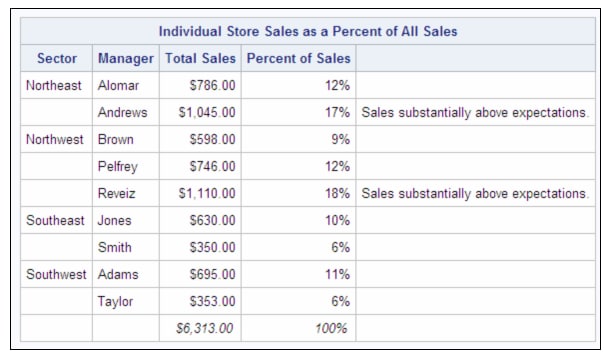REPORT Procedure
- Syntax

- Overview
- Concepts
- Using
- Results
- Examples
 Selecting Variables for a ReportOrdering the Rows in a ReportUsing Aliases to Obtain Multiple Statistics for the Same VariableConsolidating Multiple Observations into One Row of a ReportCreating a Column for Each Value of a VariableDisplaying Multiple Statistics for One VariableStoring and Reusing a Report DefinitionCondensing a Report into Multiple PanelsWriting a Customized Summary on Each PageCalculating PercentagesHow PROC REPORT Handles Missing ValuesCreating and Processing an Output Data SetStoring Computed Variables as Part of a Data SetUsing a Format to Create GroupsSpecifying Style Elements for ODS Output in the PROC REPORT StatementSpecifying Style Elements for ODS Output in Multiple StatementsUsing Multilabel FormatsUsing the WIDTH= and CELLWIDTH= Style Attributes with PROC REPORT
Selecting Variables for a ReportOrdering the Rows in a ReportUsing Aliases to Obtain Multiple Statistics for the Same VariableConsolidating Multiple Observations into One Row of a ReportCreating a Column for Each Value of a VariableDisplaying Multiple Statistics for One VariableStoring and Reusing a Report DefinitionCondensing a Report into Multiple PanelsWriting a Customized Summary on Each PageCalculating PercentagesHow PROC REPORT Handles Missing ValuesCreating and Processing an Output Data SetStoring Computed Variables as Part of a Data SetUsing a Format to Create GroupsSpecifying Style Elements for ODS Output in the PROC REPORT StatementSpecifying Style Elements for ODS Output in Multiple StatementsUsing Multilabel FormatsUsing the WIDTH= and CELLWIDTH= Style Attributes with PROC REPORT
Example 10: Calculating Percentages
| Features: |
|
| Other features: |
TITLE statement |
| Data set: | GROCERY |
| Formats: | $MGRFMT |
Details
The summary report in
this example shows the total sales for each store and the percentage
that these sales represent of sales for all stores. Each of these
columns has its own heading. A single heading also spans all the columns.
This heading looks like a title, but it differs from a title because
it would be stored in a report definition. You must submit a null
TITLE statement whenever you use the report definition, or the report
will contain both a title and the spanning heading.
The report includes
a computed character variable, COMMENT, that flags stores with an
unusually high percentage of sales. The text of COMMENT wraps across
multiple rows. It makes sense to compute COMMENT only for individual
stores. Therefore, the compute block that does the calculation includes
conditional code that prevents PROC REPORT from calculating COMMENT
on the summary line.
Program
libname proclib
'SAS-library';
options fmtsearch=(proclib);
proc report data=grocery nowd headline; title;
column ('Individual Store Sales as a Percent of All Sales'
sector manager sales,(sum pctsum) comment);
define manager / group
format=$mgrfmt.;
define sector / group
format=$sctrfmt.;
define sales / format=dollar11.2
'';
define sum / format=dollar9.2
'Total Sales';
define pctsum / 'Percent of Sales' format=percent6. width=8; define comment / computed width=20 '' flow;
compute comment / char length=40;
if sales.pctsum gt .15 and _break_ = ' '
then comment='Sales substantially above expectations.';
else comment=' ';
endcomp;
rbreak after / ol summarize; run;
Program Description
Specify the format search library.The SAS system option FMTSEARCH= adds the SAS library
PROCLIB to the search path that is used to locate formats.
Specify the format search library.The SAS system option FMTSEARCH= adds the SAS library
PROCLIB to the search path that is used to locate formats.
Specify the report columns. The
COLUMN statement uses the text in quotation marks as a spanning heading.
The heading spans all the columns in the report because they are all
included in the pair of parentheses that contains the heading. The
COLUMN statement associates two statistics with Sales: Sum and Pctsum.
The Sum statistic sums the values of Sales for all observations that
are included in a row of the report. The Pctsum statistic shows what
percentage of Sales that sum is for all observations in the report.
column ('Individual Store Sales as a Percent of All Sales'
sector manager sales,(sum pctsum) comment);Define the group and analysis columns. In this report, Sector and Manager are group variables.
Each detail row represents a set of observations that have a unique
combination of formatted values for all group variables. Sales is,
by default, an analysis variable that is used to calculate the Sum
statistic. However, because statistics are associated with Sales in
the column statement, those statistics override the default. FORMAT=
specifies the formats to use in the report. Text between quotation
marks specifies the column heading.
define manager / group
format=$mgrfmt.;
define sector / group
format=$sctrfmt.;
define sales / format=dollar11.2
'';
define sum / format=dollar9.2
'Total Sales';Define the percentage and computed columns. The DEFINE statement for Pctsum specifies a column
heading, a format, and a column width of 8. The PERCENT. format presents
the value of Pctsum as a percentage rather than a decimal. The DEFINE
statement for COMMENT defines it as a computed variable and assigns
it a column width of 20 and a blank column heading. The FLOW option
wraps the text for COMMENT onto multiple lines if it exceeds the column
width.
define pctsum / 'Percent of Sales' format=percent6. width=8; define comment / computed width=20 '' flow;
Calculate the computed variable. Options in the COMPUTE statement define COMMENT
as a character variable with a length of 40.
Specify the conditional logic for the computed variable. For every store where sales exceeded 15% of the
sales for all stores, this compute block creates a comment that says Sales
substantially above expectations. Of course,
on the summary row for the report, the value of Pctsum is 100. However,
it is inappropriate to flag this row as having exceptional sales.
The automatic variable _BREAK_ distinguishes detail rows from summary
rows. In a detail row, the value of _BREAK_ is blank. The THEN statement
executes only on detail rows where the value of Pctsum exceeds 0.15.
if sales.pctsum gt .15 and _break_ = ' '
then comment='Sales substantially above expectations.';
else comment=' ';
endcomp;